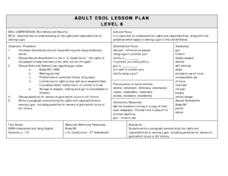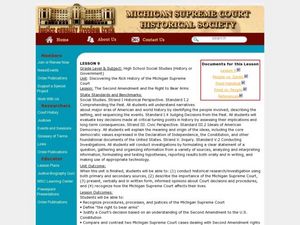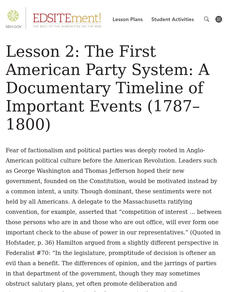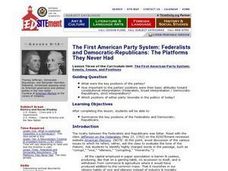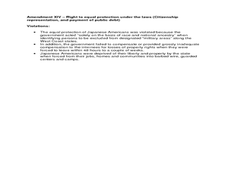Curated OER
Bill of Rights -- Texas v. Johnson, 1989
Students examine the First Amendment of the Bill of Rights. During a visit to the George Bush Presidential Museum, they watch a video about the Texas v. Johnson flag burning case. In groups, they discover the role of the Supreme Court...
Curated OER
The Right and Responsibility To Bear Arms
Students write a paragraph summarizing the rights and responsibilities of owning a gun, including penalties for owners of guns which injure or kill. This less is designed for students acquiring English.
Curated OER
Search and Seizure in Utah
High schoolers identify legal requirements of searches conducted with and without a warrant. They identify the legal standard for conducting searches in public schools. Students discuss the permit of search and seizure and have a...
Curated OER
The Second Amendment and the Right to Bear Arms
Students examine procedures and processes of the Michigan Supreme Court. They explain the Second Amendment to others. They compare and contrast two cases dealing with the Second Amendment.
Middle Tennessee State University
Fights, Freedom, and Fraud: Voting Rights in the Reconstruction Era
As part of a study of post Civil War era, young historians investigate the changes in voting rights during the Reconstruction Era (1863-1876), the fraud involved in the Hayes-Tilden presidential election of 1876, and efforts by Pap...
Library of Congress
The Emancipation Proclamation and the Thirteenth Amendment
How did the Emancipation Proclamation lead to the Thirteenth Amendment? Middle schoolers analyze primary source documents including the text of the Emancipation Proclamation, political cartoons, photographs, and prints to understand...
Curated OER
Songs the Express American Ideals
First graders will learn the words to two American ideals songs: "My Country 'Tis of Thee" and "America the Beautiful." They will also learn the Pledge of Allegiance and what it means to recite it. This is a great resource for your...
Curated OER
A House Dividing: The Growing Crisis of Sectionalism in Antebellum America
Learners explore the debates over American slavery and the power of the American federal government for the first half of the 19th century and how the regional economies and political events produced a widening split between the states.
Curated OER
A Look at the History of Book Banning in America
Why do books end up on the banned book list? How do these banned books contribute to the literary canon? Start by showing the photo slide show, and discussing notably banned books. Then focus on some of the most popular objections:...
Curated OER
By Heart
To memorize, or not to memorize: that is the question. Whether 'tis nobler to suffer the fear and anguish of committing a poem to memory, to endure the heartache, to shuffle off this fear, and face the stares of classmates with the hue...
Curated OER
Four Enlightenment Thinkers
Students examine lives, philosophies, and political beliefs of four Enlightenment Thinkers: Baron de Montesquieu, Jean-Jacques Rousseau, Thomas Hobbes, and John Locke. Students then work with partner to write short speech from...
Curated OER
Affects of Prejudicial Attitudes
Second graders explore the concept of cultural assimilation. They study the affects of prejudice on the authors of Curious George (Margret & H. A. Rey). They communicate ideas and opinions of the rights and responsibilities of...
Curated OER
Cyber-crime
Students discuss what types of Internet activity are or should be considered criminal, examine how criminal prohibitions against certain types of Internet activity are best implemented in law, determine whether computer crimes are unique...
Curated OER
Wartime and the Bill of Rights: The Korematsu Case
Twelfth graders work together in groups to examine the discrimation Japanese Americans felt after the bombing of Pearl Harbor. Using primary source documents, they analyze and discuss the case of Fred Korematsu who was placed in an...
Curated OER
The Eiserloh Story
Students read "The Eiserloh Story" and evaluate decisions made by the government in time of war. They determine if the government violated the rights of innocent civilians. They identify the Bill of Rights and analyze each Right.
Curated OER
Liberty Vs. Safety: an American Dilemma
Students study the process of consensus and the value of studying history as we try to craft a more perfect society. They examine President Franklin D. Roosevelt's decision to incarcerate Japanese Americans in the Western United States,...
Curated OER
The First American Party System: A Documentary Timeline of Important Events (1787-1800)
High schoolers conduct research on the events of the end of the 18th century in order to identify critical factors leading to the development of the Federalist and Democratic-Republican political parties. They summarize the key positions...
Curated OER
The First American Party System: Federalists and Democratic-Republicans: The Platforms They Never Had
Students investigate the beginnings of the political party system in the US. They determine the key positions of both the Federalists and the Democratic-Republicans. They compare the views of the early political parties with those of today.
Curated OER
Civil Rights and the ADA
Students examine and discuss the 14th and 15th amentments, and evaluate the agendas of Americans from underrepresented groups in the quest for civil rights. They conduct Internet research and create essays or posters regarding Civil Rights.
Curated OER
Black Soldiers in the Civil War
Students explain how a history of slavery distinguishes American society from other societies. They study posters and documents from different eras in our history which document the practice of slavery, and civil rights violations.
Curated OER
The Bill of Rights And Japanese Internment
Students review the Bill of Rights. They interpret how the American Government violated these rights with regard to Japanese Americans during World War II. They write down the violations of the Bill of Rights during Japanese ...
Curated OER
Freedom of Expression in Special Places
Young scholars analyze the judicial decision making process, and identify three places presenting First Amendment problems. They analyze how the 1st Amendment applies to school newspapers, and argue for and against limiting 1st Amendment...
Curated OER
Forced Assimilation
Students identify ways that a society promotes assimilation and examine areas where it still occurs in our present culture. They assess the value of assimilation.
Curated OER
Letters, Telegrams, and Photographs Illustrating
Students research the factors that are important in winning a battle in the Civil War. In a second activity they are assigned the role of a specific type of person during the Civil War and asked to describe what it's like being that person.



